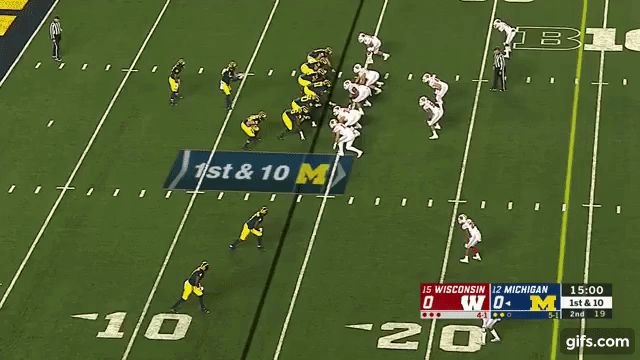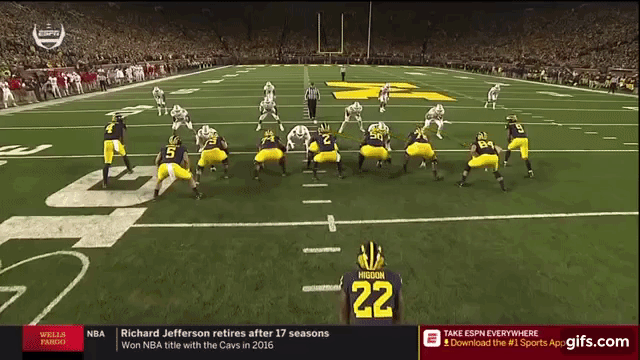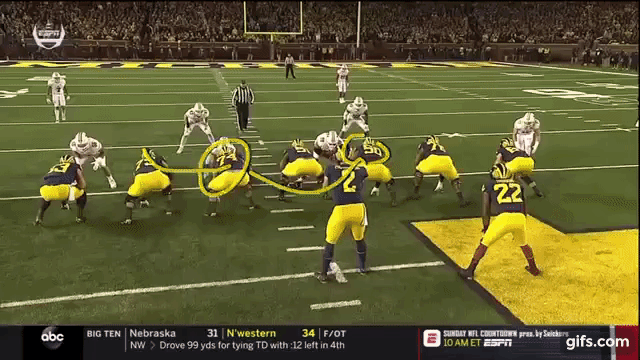Inside the Playbook: Michigan's Arc Belly Read
Against Wisconsin, Michigan expanded their QB run package by introducing a Belly Read Option with an arc block from the opposite H-back. In this post, we'll go over some of the advantages of this play and some of the intricacies that make it a successful run within Michigan's overall run scheme.
Run Scheme
Unlike a standard Inside Zone blocking scheme, this is much more of a Belly Zone run. On the backside of the play, the OL is working double teams up to the inside LBs. Because it's a Belly run, this makes the blocks something closer to traditional gap combo blocking, in that the OL can really focus on driving the first level into the second level defenders. Because the play is designed to get to the backside of the formation, it is almost like a traditional veer blocking scheme: cave in the first line right into the inside LBs. The frontside is merely fan blocking the DL across from them to ensure they can't scrape across the formation.
Being a Belly read, the RB is effectively going to an aiming point of the backside A gap. This allows the QB to have a same side read. This is a straight downhill run, there is no zone read step, the goal is to get down hill fast and attack the crease that the design of the play develops. He's going to read the MIKE in how he reacts to the combo block to recognize if he works straight down field or shifts a gap playside or backside. All this, of course, is dependent on if he receives the ball.
Because split flow is a threat, the WILL is going to have to respect Inside Zone, which forces him to run fit playside and away from the RB. This means reading the MIKE allows the play to still be a very much downhill run. MIKE respects Inside Zone, you cut it backside of him.
MIKE scrapes over the top, you cut between the ILBs.
The H-back, coming from the opposite side of the formation, will initially take a path much like split zone (which Michigan also runs a lot), before arcing around the EMOL into the second level force defender. It's important to note that Michigan does run a lot of split zone, especially from pistol, so the defense is often going to work playside on this similar look.
The QB is reading the backside EMOL. If he crashes down, he keeps. If he maintains width, he gives.
Formation
The formation here really helps set up the run though. The "nub" or closed side of the formation dictates a lot what the defense will do. For one, it sets up a 3x1 to the field. This will often force a coverage rotation. It also dictates typically a cloud leverage, i.e. the CB will be the responsible force defender, and will be the only force defender outside the EMOL. This is good to know, because it sets up the "keep read".
So against Cover 1, your CB is lined up to cover the Y-TE. When he blocks down, he now is the leverage defender to block. There is no other DB filling in behind him because the coverage has been dictated.
And most Cover 4 teams are going to adjust by running a "nub" check, which effectively changes the coverage to Cover 6 (quarter-quarter-half). This leaves the safety in a deep half, rather than his standard safety run fit, and traditionally leaves him with attacking interior run gaps in run support rather than the alley (because an alley fit would typically be redundant); this is also why this play is run into the short side of the field, as the safety will traditionally stay near the hash, leaving his angle to the play much more shallow.
Because the CB is the only force defender, the arc blocker can easily get out to him and handle the only guy outside the EMOL. Because of the read element of the play, the EMOL is effectively blocked and always on the wrong side of the run (assuming the read is made correctly).
If the EMOL stays outside, the RB has an opportunity to get north-south fast to hit the noticeable crease created by the combo blocks to the LBs and the two defenders being stuck wide.
If the EMOL comes inside, it's often a TE vs a CB block that can easily spring a long QB run. The formation here is a major part of the success of this play.
Examples
How this Benefits the Rest of the Playbook
The first obvious thing this helps is the split zone runs. In the first example above, you see the defensive EMOL attempting to block up the split flow and wrong arm it, creating a pile on the backside. This arc block will effectively widen that player out.
This example is from under center but the point has been made. Look how wide the backside force defender sets up. That sets up a huge cutback lane for the RB on split Inside Zone.
The other thing it does is that it slows down the backside pursuit. Now when the defense sees zone blocking, they can't immediately attack over the top to fit their playside gaps, because they are worried about the pressure that this belly read puts on the backside of the formation. You see that here with how slow the backside LB is coming over the top of the play. Even though these are from gun instead of pistol, the theory still applies (and certainly, the belly read can still be run from gun, as OSU took full advantage of on their way to the National Championship a few years back).
Harbaugh starting to break out the read runs from his 49ers days with Colin Kaepernick. Big run by Shea Patterson was "12/13 EAT". It's zone read arc from 12/21 personnel twins. Closed formation dictates predictable coverage. F arcs for the CB. pic.twitter.com/dt1Hwp74CN— James Light (@JamesALight) October 14, 2018
Run Scheme
Unlike a standard Inside Zone blocking scheme, this is much more of a Belly Zone run. On the backside of the play, the OL is working double teams up to the inside LBs. Because it's a Belly run, this makes the blocks something closer to traditional gap combo blocking, in that the OL can really focus on driving the first level into the second level defenders. Because the play is designed to get to the backside of the formation, it is almost like a traditional veer blocking scheme: cave in the first line right into the inside LBs. The frontside is merely fan blocking the DL across from them to ensure they can't scrape across the formation.
Being a Belly read, the RB is effectively going to an aiming point of the backside A gap. This allows the QB to have a same side read. This is a straight downhill run, there is no zone read step, the goal is to get down hill fast and attack the crease that the design of the play develops. He's going to read the MIKE in how he reacts to the combo block to recognize if he works straight down field or shifts a gap playside or backside. All this, of course, is dependent on if he receives the ball.
Because split flow is a threat, the WILL is going to have to respect Inside Zone, which forces him to run fit playside and away from the RB. This means reading the MIKE allows the play to still be a very much downhill run. MIKE respects Inside Zone, you cut it backside of him.
MIKE scrapes over the top, you cut between the ILBs.
The H-back, coming from the opposite side of the formation, will initially take a path much like split zone (which Michigan also runs a lot), before arcing around the EMOL into the second level force defender. It's important to note that Michigan does run a lot of split zone, especially from pistol, so the defense is often going to work playside on this similar look.
The QB is reading the backside EMOL. If he crashes down, he keeps. If he maintains width, he gives.
Formation
The formation here really helps set up the run though. The "nub" or closed side of the formation dictates a lot what the defense will do. For one, it sets up a 3x1 to the field. This will often force a coverage rotation. It also dictates typically a cloud leverage, i.e. the CB will be the responsible force defender, and will be the only force defender outside the EMOL. This is good to know, because it sets up the "keep read".
So against Cover 1, your CB is lined up to cover the Y-TE. When he blocks down, he now is the leverage defender to block. There is no other DB filling in behind him because the coverage has been dictated.
And most Cover 4 teams are going to adjust by running a "nub" check, which effectively changes the coverage to Cover 6 (quarter-quarter-half). This leaves the safety in a deep half, rather than his standard safety run fit, and traditionally leaves him with attacking interior run gaps in run support rather than the alley (because an alley fit would typically be redundant); this is also why this play is run into the short side of the field, as the safety will traditionally stay near the hash, leaving his angle to the play much more shallow.
Because the CB is the only force defender, the arc blocker can easily get out to him and handle the only guy outside the EMOL. Because of the read element of the play, the EMOL is effectively blocked and always on the wrong side of the run (assuming the read is made correctly).
If the EMOL stays outside, the RB has an opportunity to get north-south fast to hit the noticeable crease created by the combo blocks to the LBs and the two defenders being stuck wide.
If the EMOL comes inside, it's often a TE vs a CB block that can easily spring a long QB run. The formation here is a major part of the success of this play.
Examples
How this Benefits the Rest of the Playbook
The first obvious thing this helps is the split zone runs. In the first example above, you see the defensive EMOL attempting to block up the split flow and wrong arm it, creating a pile on the backside. This arc block will effectively widen that player out.
This example is from under center but the point has been made. Look how wide the backside force defender sets up. That sets up a huge cutback lane for the RB on split Inside Zone.
The other thing it does is that it slows down the backside pursuit. Now when the defense sees zone blocking, they can't immediately attack over the top to fit their playside gaps, because they are worried about the pressure that this belly read puts on the backside of the formation. You see that here with how slow the backside LB is coming over the top of the play. Even though these are from gun instead of pistol, the theory still applies (and certainly, the belly read can still be run from gun, as OSU took full advantage of on their way to the National Championship a few years back).














THANK YOU FOR POSTING AND EXPLAINING THE X'S AND O'S. IT'S AWESOME INSIGHT (ESPECIALLY FOR A WOLVERINE FAN)
ReplyDelete